Uyuni, Bolivia
13th September – 15th September 2017
After everyone had returned from the mines, we left Potosi just before 2, to head 240km down the country to Uyuni. Being back on Yana with just the eight of us was still strange, but we all seemed to gravitate to the same chairs and the same positions ready to nap.
Not long after we had set off, Lars jumped into the back to explain the next few days, then we had some hours ahead of us to enjoy the ride. We haven’t been a very sociable group for the first couple of rides: we all spread out, lie down and sleep.
Similar to the last ride in Yana, I began to feel sick not long after we set off. I tried to lie down and sleep it off but it didn’t really work for very long. I think I just try and get too comfy with all the space and sitting sideways while going over the windy roads isn’t helpful because I felt okay once I sat up normally.
At around 4 o’clock, we stopped for a photo stop and toilet stop. As beautiful as the scenery was, I couldn’t go for a wee there: it was far too cold and windy!
We carried on towards Uyuni and had one final photo stop as we came over the mountain and could see the town on Uyuni ahead of us, with the salt flats in the distance, on the horizon. We jumped out and took some photos but it was chilly, so we didn’t stop for long.
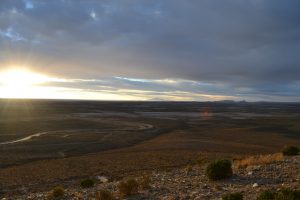
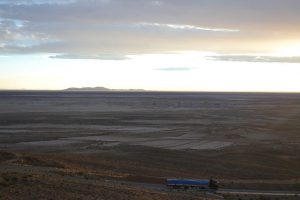
We pulled up to the hotel at around 6.30 and Amber was already there; I’m not sure how they beat us because we left Potosi before them, but anyway. Once we were checked in, I managed to have a quick shower before we were booked into the hotel restaurant for dinner at 7. According to Sarah it is the nicest pizza in South America.
I ordered a chicken fajita pizza and although it tasted good, the conversation around the table at the time knocked my taste buds. People decided to have the ‘what’s the weirdest thing you’ve eaten?’ conversation, so there was talks of frogs, worm, grasshoppers and all sorts, it didn’t help me!
After dinner, we sat at the table and chatted for a while. Me and Katie were in talks about getting a dessert but we couldn’t decide. In the end, Jack sent us up to the counter and basically told us not to come back without something, so we decided to share a piece of hot chocolate cake with chocolate sauce – it was a good decision. We stayed and chatted for a while after that, before one by one we all ended up going to our rooms, to bed.
We were allowed another lie in on our full day in Uyuni; I can’t get used to all this extra sleep though, so I was awake at around 7.30. I lay in bed for a while and took my time getting ready, before strolling down for breakfast at around 9. Breakfast was tasty: we had waffles and pancakes and all sorts of different treats.
After breakfast, we had until 10 to get ourselves ready and meet in reception. We were joining up groups with Amber’s passengers, so there were 5 jeeps between us all. We had to just pick a jeep and get in, I was with Katie, Jack, Aaron, Joe, Char and Sian (from Amber); it didn’t really matter who was in the jeeps because we all went to the same place.
Our first stop for the day was the train graveyard; it was really cool to see. We had a local guide with us, but he only spoke Spanish, so Rianne and Sara had to translate for us. The train graveyard is where all of the crashed or broken trains were left because they could no longer be used. The trains and the track were built and provided for, by the English, in order to transport minerals around the country, so all of the trains (apart from two, which were American) were English. The English would support the trains on the condition that they could keep any profits for the first fifty years. All of the workers along the train lines were English, besides the very low level jobs, which were done by the locals. At one point, the government decided to sell useful parts of the old trains to Argentina, until they realised that the trains dumped there were actually a tourist attraction, so then they stopped it and made it into an outdoor museum. The trains were abandoned in the 1940s.
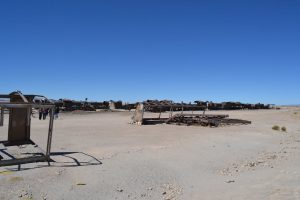
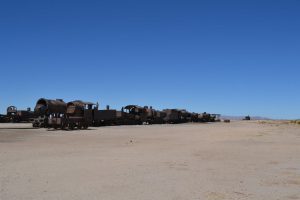
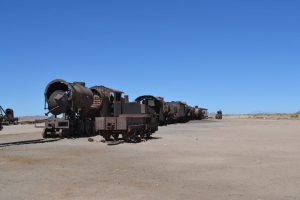

The train line is still used today for transporting some minerals. There is a train that runs in one direction one day of the week between two cities and then it runs back in the opposite direction a different day of the week.
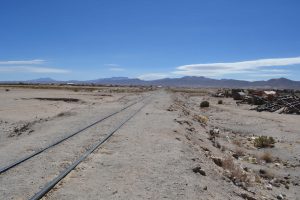
After the explanation, we were allowed half an hour to explore the trains – it wasn’t long enough. Once we were let loose, we were all like big kids because we were able to climb onto and into the trains as much as we wanted. As much as I loved this, my legs were genuinely like jelly (which isn’t usually like me) but I still did my best anyway despite everyone laughing at me; I did have to be rescued down by Tom at one point, so I couldn’t blame them! Climbing onto the trains also made for some very cool photos, so it was definitely worth it and I could have definitely spent longer there.
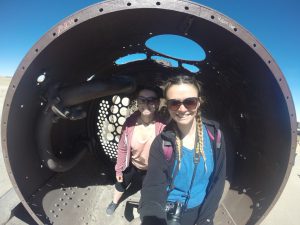
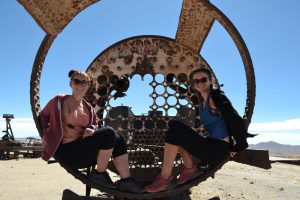
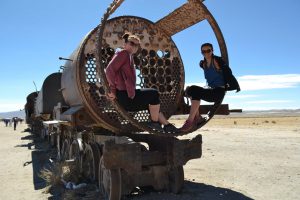
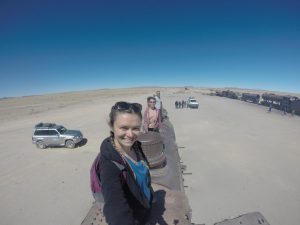
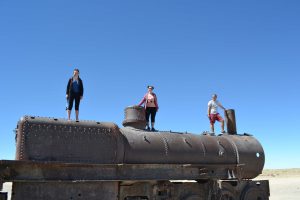

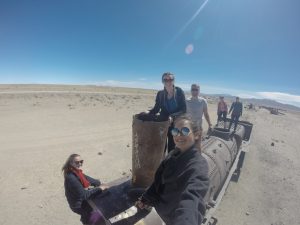
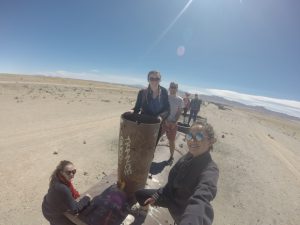
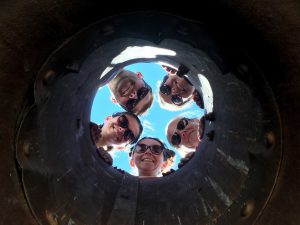
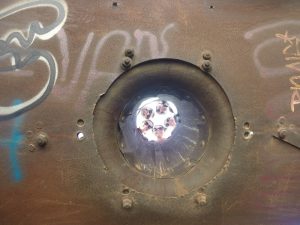
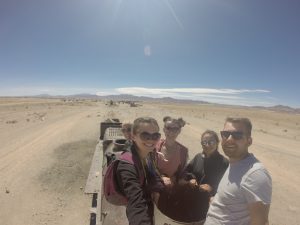
After the train graveyard, we drove to Salar de Uyuni (the salt flat city). We stopped off in a little village first and had a demonstration of how the salt gets from the ground, onto the dinner table. They explained to us that they have to go about 6km into the salt flats to extract the salt that they want.
Once they have extracted the salt, it is too wet to use, so they have to put it above some fires to evaporate all of the water. After the salt has been dried out, it is piled up, before being ground down in a machine. Once it has been made much finer, they add iodine to it to make it edible and then bag it up, ready to sell. They have the bags made already, so just scoop up some salt and seal the bag at the top with fire.
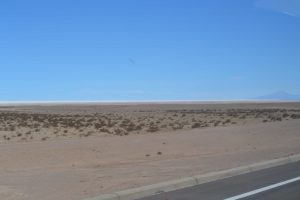

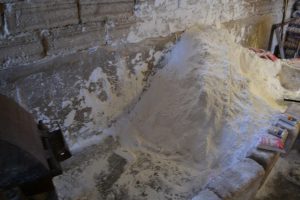
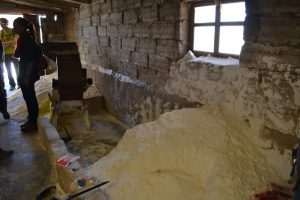
After the demonstration, we were able to look around their market stalls before getting back into the jeeps.
Our first stop on the actual salt flats was to see the Dakar racing statue. Lots of people were very excited about this but it didn’t actually mean anything to me. Apparently the racing has been moved here from Africa because there are too many civil wars happening over there, so the statue is on the salt flats. The salt flats are also a good place to test out car speed (apparently), so many car companies do.
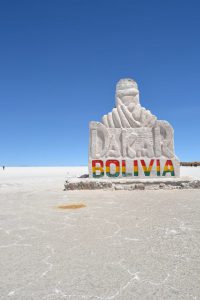
At the same place as the Dakar statue, was a whole set of flags which were pretty cool to see. I assume people from those countries have brought their flag there and hung it up.
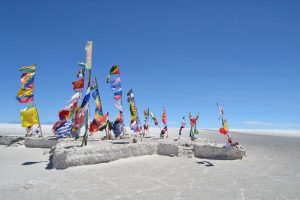
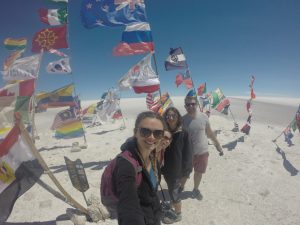
After we got back into the jeeps, I was told that the next stop was lunch – this was unfortunately not true. We stopped off in the middle of the salt flats, where our guide told us some information about them, including theories as to why they are there.
The salt flats in Uyuni are the biggest salt flats in the world, at 12,000 square kilometres and 3650m above sea level. Due to the salt flats being so high, in the winter, the temperature can drop to -18 degrees in the evening time; we are in the beginning of spring at the moment, so it only gets to around -1 in the evenings.
The salt rocks are made up of 80% sodium chloride and the other 20% is bosch, potassium and magnesium. The further down into the salt you go, the bigger the crystals are. Where we were stood, the salt layer was roughly 20-25m deep with lots of pockets of shallower places where we could see the water and put our hands in, but it was obviously very salty; the liquid also contained lots of lithium. In total, the salt flats are predicted to be around 100m deep with sandwiched layers of salt layers and water layers.
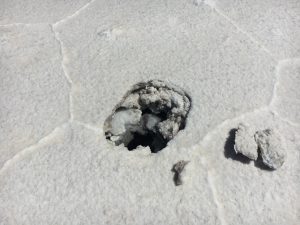
It was thought that the ancient lakes were around 140m deep before they disappeared and the salt flats were formed. There are two theories that we were told about. The first theory is that the Pacific and Atlantic tectonic plates hit each other thousands of years ago and pushed upwards, causing the land to move higher, taking some of the sea water with it; this then resulted in there being the big section of water. The water had many islands around it. The large volcano by the salt flats (Volcano Tunupa) then erupted one day and the hot lava balls that came out from the eruption evaporated all of the water and left behind the salt flats.
The second theory is that when the volcanos erupted, they brought all of the salt up and created the salt flats, but this one seems less likely because it doesn’t explain where the water came from. There is no one that knows exactly how the salt flats were formed and Sara said that she has had geologists on her tours in the past who have queried both of the theories, so who knows. The one thing that they do know is the islands have black volcanic rock on them and then petrified coral on top; it is thought that the coral just clung onto any land possible when the water disappeared.
We were able to have a look into some of the water holes after the explanation and see what we could find down them. On the land, Sabrina found a giant salt crystal which she became obsessed with – it was very cool to look at though. We had a look around for a little while before getting back into the jeeps and driving a bit further to an island (Incahuasi) – I found it strange calling it an island because it wasn’t surrounded by visible water.

We knew that we were getting lunch at the island (even though it was now 3 o’clock). We got dropped off at one side of it and could take some photos and wander around to the other side. Once we got round the other side, we were met with our tickets for the island and had the chance to climb to the top of the island while lunch was prepared – I was wasting away at this point. It wasn’t a far walk and it wasn’t very steep either, but we were all hungry and not many people were in the mood but we went anyway. The views were pretty cool from the top, we were surrounded by giant cactus and could see far out into the salt flats and we could see the volcanoes in the distance – it made for some good photos.
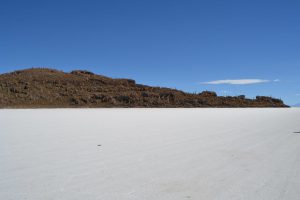
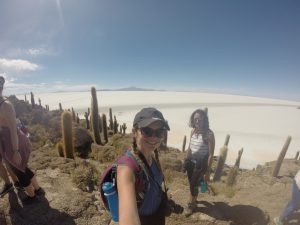

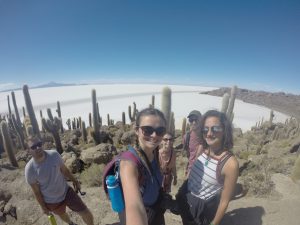
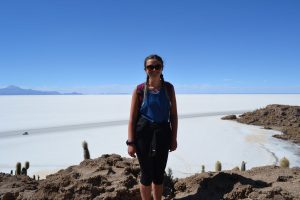
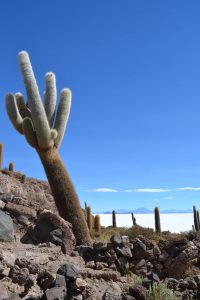
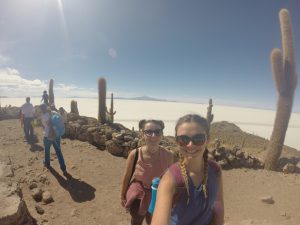
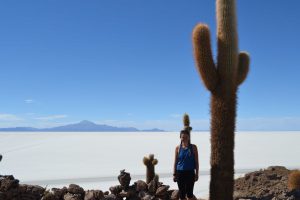
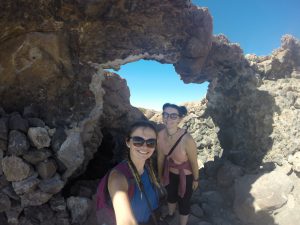
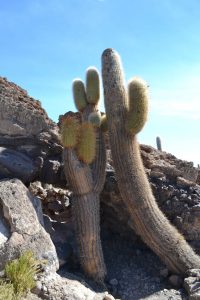
When we got back to the bottom, everyone was already tucking into their food! No one else had gone up apart from our little group (me, Katie, Sabrina, Jack, William and Aaron), but I was just happy I could eat when I got back. Lunch was chicken and potatoes and pasta and bread and salad, so there was enough to fill us all up.
After lunch, we then had loads of time to spare, while the other group decided to go on their walk up to the top of the island. We just sat around and let our food digest while we waited.
We drove a little further once everyone was back. Our guides found us a spot which was just flat, white salt with not much in the background, so that people could take perspective photos. We weren’t very good at this, so I gave up very quickly and just took normal photos – they still looked pretty cool.
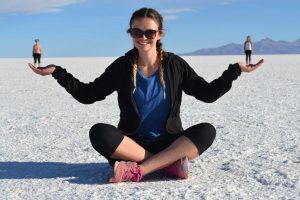
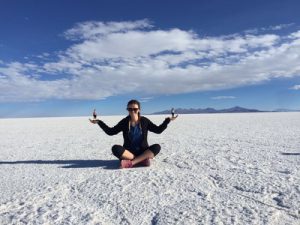
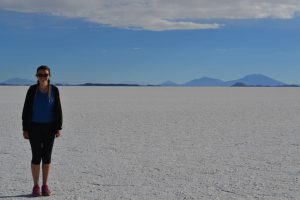
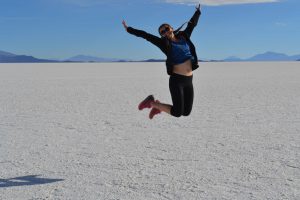
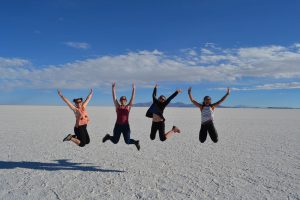
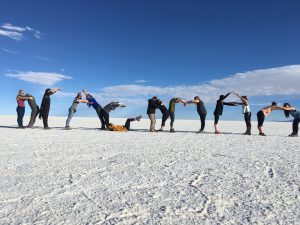
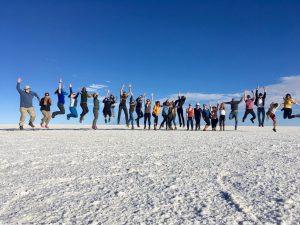
After a lot of fun, we got back into the jeeps and drove further round the salt flats. We were driving for over an hour before we got to our final stop of the day. We arrived at a place in the flats where there were lots of piles of salt around which looked just like snow. We stopped here and got out ready to watch the sun set. They were pretty good views and it was another beautiful sunset to witness. We were so focused on watching the sun though that we didn’t realise behind us were beautiful views of mountains. As the sun went down, the clouds changed colours but no photograph could do justice to the views that we had.

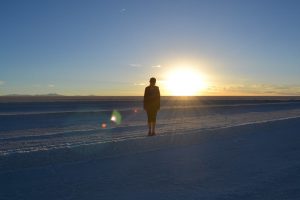
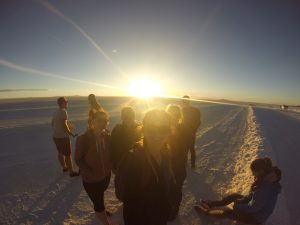
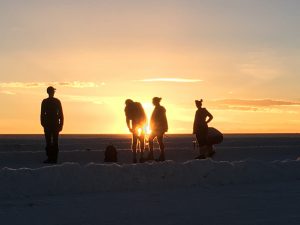
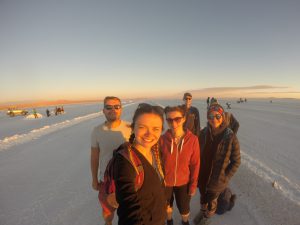
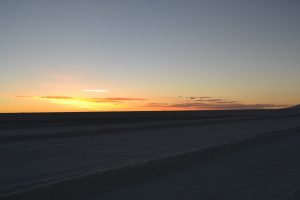
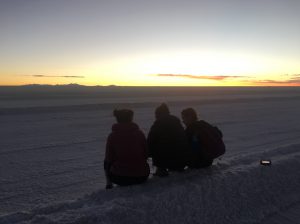
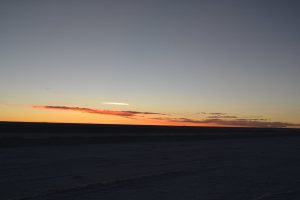
Once the sun had set, we drove back to Uyuni. It wasn’t too far to drive but we had to stop off a couple of times on the way but I’m not sure why because I couldn’t understand the Spanish. We got back to the hotel at 7.20 and Lars called a quick meeting about the next couple of days.
After the meeting, we dropped our bags off in the room and went for dinner. For dinner, we decided to go to the same restaurant as the previous night because the pizza was good and we didn’t have to leave the hotel. I ordered a different pizza though, I got a buffalo chicken pizza with blue cheese – it was nicer than the fajita one.
After dinner, we sat in the restaurant for a bit and had a bit of a chat while the other group were getting very loud on the table behind us. Everyone gradually drifted off to bed again, so I wasn’t far behind them.
I got myself up early on the morning we left Uyuni. I had a shower and packed before we went down for breakfast. Breakfast was good again: I had more waffles and pancakes with dolce de leche.
We had to all meet at 9 o’clock to go food shopping for the cook groups. Being the ‘leader’ I was given 200 Bolivianos to spend on lunch for the day and Jack’s group was given the same for the following day’s lunch. Lars came with us to shop but I’m not sure why, I think he was just showing us where to go. Because I was buying for the same day, I decided on empanadas for lunch – nice and easy and no preparation required. We bought 11 of each kind that the lady had, so that there was enough for two each (we also had the tour guide on our truck for the next couple of days) and it only cost 77 Bolivianos (£8.50 for 22 empanadas)! To go with the empanadas, we bought an apple each from the market and then a cookie each from the hotel – we were really treating everyone. We even had money to spare at the end!
After the food shop, we went back to the hotel and put the food on the truck. We then had a little time to chill before doing back locker and leaving at 10.30.
I loved going to Uyuni and seeing the salt flats – they were definitely a highlight of the trip so far! It was definitely good to do something again after having a week of doing practically nothing – I am not one for sitting around and not doing much, so I’m glad things have got going again. Next stop, the Altiplano – our final stop in Bolivia!
To travel is to live, Katie x
2 Replies to “Uyuni, Bolivia”
Wow, fabulous photos yet again 💕💖💕
Looks like you have had lots of fun on this stop! 😘Xx